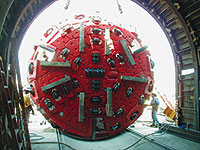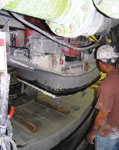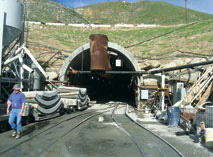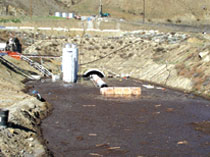...work in earth pressure balance mode for short periods and can accommodate water pressures up to 10 bar. The TBMs are the same design for both tunnels but the machine working the east tunnel is fitted with more extensive dewatering equipment. Both tunnels require three types of grout, controlled by computer, as are segment placing and TBM operation.
 |  |
| Cut and Place. TBM is designed for cutting hard rock but is fitted with shield to handle water inflow. Segments are lifted by vacuum. (Photo left courtesy of the Metropolitan Water District of Southern California; photo right by John J. Kosowatz for ENR) | |
This time, project officials wanted a better idea of what lays ahead of the machines so the cutterheads are fitted with ports allowing probes to reach 100 to 150 ft ahead of the bore. Probe drilling is mandatory and two are always in use. If inflows exceed .3 gallons per minute per probe, mining halts while grout is injected through other ports, ahead of the machine. When flows recede, mining begins again, says John Townsend, project manager with construction manager Hatch Mott McDonald. Spoil is removed with a train of muck cars.
Behind the cutterhead, crews are erecting a precast concrete segmental liner that, combined with aggressive grouting of the annular space, is designed to withstand 900 ft of hydrostatic head and handle a magnitude 8 earthquake. Tests of the system were conducted prior to construction at the University of Illinois. The tunnels will be fitted with concrete-reinforced steel pipe to a finished diameter of 12 ft.
"We tried to take the original design and move it forward," says David Crouthamel, tunnel engineer for Jacobs & Associates, San Francisco. Jacobs and Bechtel Engineering won the task to redesign after MWD shut the job down in 2000. Crouthamel says the team drew on concepts from the English Channel Tunnel project and others faced with high water pressures. "This is pushing the envelope as far as hydrostatic head," he says.
Crouthamel believes San Diegos outfall carries the highest functional design, at about 400 ft of head. For comparison, the Channel Tunnel was designed to withstand a range of 350 to 360 ft of head, he says.
Key to the design are the 13.5-in.-thick, trapezoidal precast segments, fitted together and secured to tunnel walls with bolted gaskets. They are produced in a casting yard in nearby Palmdale by a joint venture of Shea, Traylor Bros. and Ghazi Contractors. At 6,000 and 8,000 psi of compressive strength, they are above average for industry standards. "Thats a pretty thick segment for such a small diameter bore," says Crouthamel. "Its a fairly robust design."
Segments are delivered to the rear of the TBM, where a vacuum lift moves them onto a feeder under a conveyor. When five segments and a key that comprise a ring are loaded, another vacuum erector picks and places them for bolting.
Segments are cast with exterior vertical grooves and openings for grout bags that are filled after placement. As grout is injected, the bags expand against the wall, creating a seal that prevents groundwater from moving along the sides to any exposed openings.
"It is really pretty forgiving," says Crouthamel. "The segments are so thick and with the [small] diameter of the tunnel, its not highly flexible."
Natural Disasters
Besides difficult conditions underground, the project also has taken hits from the surface. Local wildfires swept through the dry, hilly area in 2003, coming close to the tunnel portal at Waterman Canyon, above San Bernardino. Shea/Kenney had removed brush around the site, creating an effective fire barrier that prevented damage.
 |  |
| Buried. Waterman Canyon portal was inundated in a mudslide, stopping work for months.(Photo left by John J. Kosowatz for ENR, photo right courtesy of the Metropolitan Water District of Southern California) | |
But the project took a direct hit on Christmas Day of 2003, when massive mudslides swept down canyon walls and inundated the west portal in Waterman Canyon. The mud buried the TBM and shut down the job for three months. Although the slides were deadly, there were no worker injuries because the job was closed for the holiday. Overall, the owner reports only a few minor injuries on the project.
That event and slow progress in the west tunnel have pushed the schedule back from March 2007 to the end of 2007 or early 2008, says Tempelis. Grouting can take longer than anticipated if major water problems develop, a situation that can give the contractor "day to day extensions," says Tempelis.
The contract specifies liquidated damages of $2,500 per day but it is still too early in the project to anticipate. "We are delayed but its hard to predict" a finish date, he says. "This next year is going to be critical."

Post a comment to this article
Report Abusive Comment